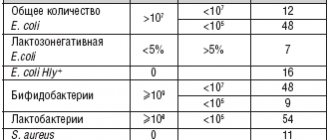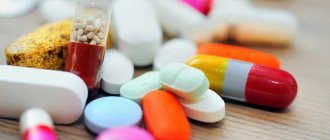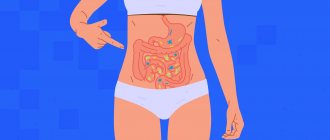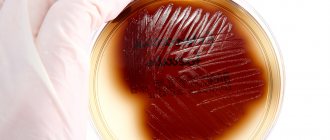Small and large intestine
Small intestine
From the stomach, chyme (food gruel) enters the small intestine - the section of the digestive tract next to the stomach, 5-6 meters long in an adult. The small intestine consists of three sections:
- Duodenum
- Jejunum
- Ileum
The environment in the small (and large intestine) is slightly alkaline. Intestinal enzymes are activated in it, and stomach enzymes, active in an acidic environment, once in the intestinal cavity, are inactivated, since this environment changes the conformation of their molecules, and they lose the ability to break down food particles.
In the small intestine, digestion is represented by two types: parietal and cavity. Cavitary digestion occurs in the cavity of the small intestine, where enzymes act on the food mass (on large molecules - polymers).
After large molecules are broken down into smaller ones (oligomers), the next stage becomes possible - parietal digestion, which takes place on the outer membrane of the cells of the small intestine mucosa.
The mucous membrane of the small intestine is distinguished by the presence of special outgrowths - villi, which greatly increase the absorption area. After cavity and then parietal digestion, monomers are formed - tiny particles of food that are absorbed into the blood (unlike large polymers).
Remember the two main functions of the small intestine:
- Digestion
- Cavitary - in the intestinal cavity
- Parietal - on the surface of the villous epithelium
In the small intestine, all substances are finally digested: proteins, fats and carbohydrates. This occurs thanks to intestinal juices, pancreatic juice and liver bile - together, all the enzymes necessary for digestion are present here.
The absorption of monomers by the villi of the small intestine varies. Amino acids formed as a result of the breakdown of proteins and simple carbohydrates are absorbed into the blood, and glycerol and fatty acids formed as a result of the breakdown of fats are absorbed into the lymph. The lymphatic system connects to the circulatory system, so fats will eventually end up in the blood.
The muscular wall of the small intestine provides its motor function (Latin mōtor - driving). Inside the small intestine, food is mixed, mashed and gradually moved towards the next part of the digestive system - the large intestine.
The movement of food occurs due to the contraction of the muscles of some parts of the intestine, and the relaxation of others: peristaltic waves occur.
Colon
Consists of the blind, colon (ascending, transverse, descending, sigmoid) and rectum. The large intestine is the final section of the digestive tract, about 1.5 m long. The participation of the large intestine in digestion is insignificant and occurs mainly due to enzymes that enter it from the small intestine.
From the cecum comes a vermiform appendix, the appendix, the inflammation of which is called appendicitis.
During normal digestion, most of the broken down proteins, fats and carbohydrates are absorbed in the small intestine. Undigested residues enter the colon along with plant fiber, which is not broken down by human enzymes.
The human body and other animals resort to an unusual maneuver to break down fiber. It enters into symbiosis with millions of bacteria that populate our large intestine: intestinal microflora is formed. Thanks to bacteria in the colon, plant fiber (cellulose) is successfully broken down.
Bacteria synthesize vitamin K, which is involved in the blood clotting process. In the large intestine, proteins rot and previously unabsorbed amino acids are destroyed. The formation of feces and the absorption of water also occur here: about 4 liters of liquid are absorbed in the large intestine per day.
The composition of feces includes: bacteria (up to 50% of the mass), undigested food debris, dead epithelial cells. The dark color of stool is given by decayed bile pigments.
Having reached the final section of the rectum, feces accumulate and stretch its walls, which causes the urge to defecate. This process is under the control of the cerebral cortex and occurs voluntarily, as evidenced by the ability to control it.
Let us summarize our study of the colon. It performs the following important functions:
- Due to microflora
- Fiber breakdown
- Destruction of unabsorbed amino acids
- Vitamin K synthesis
Diseases
Crohn's disease is a severe inflammatory disease that can affect all parts of the gastrointestinal tract, from the mouth to the rectum. In most cases, the pathological process affects the ileum and the initial part of the colon.
The processes of digestion and absorption are disrupted. Crohn's disease is accompanied by weakness, abdominal pain, diarrhea, nausea, vomiting, bloating and weight loss. The cause of the disease remains unknown; the role of genetic, infectious and autoimmune factors is suggested.
© Bellevich Yuri Sergeevich 2018-2022
This article was written by Yuri Sergeevich Bellevich and is his intellectual property. Copying, distribution (including by copying to other sites and resources on the Internet) or any other use of information and objects without the prior consent of the copyright holder is punishable by law. To obtain article materials and permission to use them, please contact Yuri Bellevich
.
How to maintain the diversity of intestinal microflora?
Healthy people tend to have a more diverse gut microflora. Therefore, one important aspect of health is microbial diversity in the gut.
Tips to help preserve intestinal microflora:
- eat a variety of foods and include vegetables and fruits, whole grains rich in fiber, and dairy products in your diet;
- maintain a healthy weight;
- normalize night sleep;
- engage in physical activity;
- stop smoking and drinking alcohol.
- do not take antibiotics and other medications that affect microflora, including food supplements with prebiotics and probiotics, without a doctor’s prescription;
The diet, and especially the presence or absence of a sufficient amount of indigestible plant fiber, has a significant impact on the composition of the intestinal microflora. To choose a suitable diet, you can use the rule of three “Ps”: including in your daily diet foods that naturally contain polyphenols* and prebiotics* from plant foods and probiotics* from naturally fermented dairy and plant products. This diet corresponds to the Mediterranean diet.
*Polyphenols are organic compounds found in most plants and have antioxidant properties.
*Prebiotics are food components that can only be digested with the help of enzymes secreted by intestinal microflora bacteria and serve for their nutrition and growth. Prebiotics are found naturally in food and can be isolated and formulated as food supplements; there are also artificially synthesized prebiotics.
*Probiotics are live microorganisms that are part of the normal intestinal microflora, improve the condition of the gastrointestinal tract (GIT) when used correctly and can be found both naturally in food and in the form of dietary supplements.
List of foods rich in probiotics:
- natural yogurt with active live culture without added sugar. Not all yogurts contain live probiotics; the composition of the product is indicated on the label;
- other fermented milk products - kefir, yogurt, acidophilus, bififruit;
- unpasteurized sauerkraut;
- fermented soy products (tempeh, miso paste, natto);
- kimchi - a Korean dish made from pickled vegetables;
- unpasteurized vegetable pickles prepared without vinegar;
- some types of cheese (mozzarella, gouda, cheddar).
Types of prebiotics and products that contain them:
- oligosaccharides, carbohydrates consisting of simple sugars, are found in dairy products, fresh fruits and vegetables;
- polysaccharides are complex carbohydrates, found mainly in tubers and root vegetables (inulin) and in many vegetables, fruits, grains and legumes (cellulose, pectin).
Features of the organ
The duodenum is a very important organ of the digestive tract.
The location of the digestive tract is the area between the second and third lumbar vertebrae.
Most often it covers the head of the pancreas. It is characterized by various forms that do not affect the process of performing functions. The duodenum consists of 4 sections:
- Upper horizontal;
- Lower horizontal;
- Ascendant;
- Descending.
Variations in their location are directly influenced by the individual characteristics of the human body, as well as some other factors. For example, when a person stands, there is a shift in the digestive tract to the right side.
The upper part of the digestive tract is a continuation of the pyloric part of the stomach. Since the organ has a sharp bend, this leads to its sharp limitation from the next section of the stomach.
If you look at the organ on an x-ray, the upper part resembles a ball in shape. That is why it is called the onion of the gut. The upper part of this organ continues with the descending section.
The medial side of this section is characterized by the presence of a large or Vater nipple. At this point, the duodenum connects with the ducts of the gallbladder and pancreas. The minor nipple is located not far from the nipple of Vater. This is a special opening into which the accessory duct of the pancreas enters.
Modern ideas about intestinal dysbiosis (dysbacteriosis)
Dysbiosis (dysbacteriosis) is a pathological condition in which the qualitative and quantitative composition of the intestinal microflora is disrupted compared to normal. For the colon, this term refers to a decrease in the number of beneficial microorganisms and an increase in the number of representatives of pathogenic flora. For the small intestine, in which in a healthy state the number of microorganisms is minimal, dysbiosis, on the contrary, is associated with an increase in the number of microorganisms. Small intestinal dysbiosis is called bacterial overgrowth syndrome (SIBO).
Causes of dysbiosis (dysbiosis) of the colon:
- unbalanced diet and insufficient fiber intake;
- water quality;
- alcohol abuse and smoking;
- antibacterial therapy and occupational exposure to antibiotics;
- long-term use of other medications;
- any acute and chronic infections;
- developmental anomalies, operations and their complications;
- primary and secondary immunodeficiencies;
- chronic gastrointestinal diseases and endocrine disorders;
- radiation;
- elderly age.
At the initial stage, colon dysbiosis has no noticeable symptoms and is reflected only in laboratory examination of stool samples. At a more advanced stage, noticeable manifestations appear.
Symptoms and manifestations of colon dysbiosis:
- bowel dysfunction - constipation or diarrhea;
- bloating and increased gas formation;
- stomach ache;
- food or drug allergies;
- metabolic disease;
- anemia, abnormal cholesterol levels;
- functional intestinal disorders;
- liver damage and others.
Functions of the duodenum
The duodenum performs many different functions in the digestive process.
The organ is characterized by a rather complex structure, which allows it to perform various functions during the digestion process.
One of the most important of them is the secretory function. With its help, food gruel and digestive juices are mixed.
Which enter this section of the intestine from such organs. Like the gallbladder and pancreas. The duodenum is characterized by the presence of its own glands, which act as active participants in the process of formation of pancreatic juice.
Since digestive enzymes enter the organ, this leads to the acquisition of a unique enzyme charge by the chyme. After this, the food is digested in the lower parts of the digestive tract.
The section of the digestive tract is characterized by the presence of motor function. Thanks to it, the chyme that comes from the stomach moves correctly through the small intestine. The organ fully performs the evacuation function.
Chyme, which is characterized by the presence of a large number of digestive enzymes, is fully evacuated to other parts of the small intestine. Due to the presence of a special function, the duodenum maintains an inverse relationship with the stomach.










